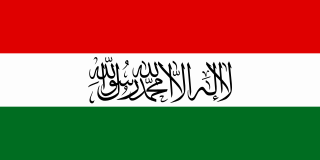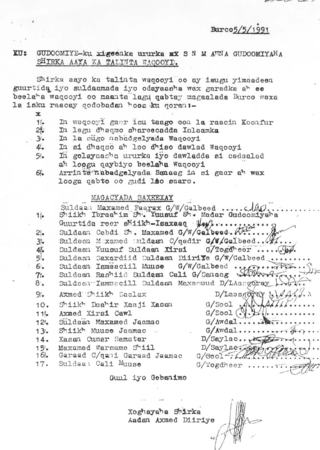
Burao, also spelt Bur'o or Bur'ao, is the capital of the Togdheer region and the second largest city in Somaliland. Burao was the site of the declaration of an independent Somaliland on 18 May 1991.

The Habar Yoonis alternatively spelled as Habr Yunis is a major clan part of the wider Isaaq clan. As descendants of Ismail bin Sheikh Isaaq, its members form a part of the wider Habar Magaadle confederation which constitutes one of the largest sub-clans of the Isaaq.

The Isaaq is a major Somali clan. It is one of the largest Somali clan families in the Horn of Africa, with a large and densely populated traditional territory.

The Habr Garhajis also contemporarily known as the Garhajis is a major clan of the wider Isaaq clan family. They are the traditional holders of the Isaaq Sultanate and Habr Yunis Sultanate since the 18th century. As descendants of Ismail bin Sheikh Isaaq, its members form a part of the Habar Magaadle confederation, and they constitute one of the largest sub-clans of the Isaaq. The Garhajis are divided into two major sub-clans: the Habr Yunis and Eidagale. They are traditionally nomadic pastoralists, merchants and skilled poets.moreover they are one of the most feared tribes in the Somali peninsula pushing deep into the Ogaden territory in Ethiopia and the Warsangali in eastern Sanaag region.

Ahmed Mohamed Mohamoud, known by his nickname Silanyo, was a Somaliland politician who served as the President of Somaliland from 2010 to 2017. He was a long-time member of the government in Mogadishu, having served as Minister of Commerce of Somalia in the 1960s, and among other Cabinet positions. During the 1980s, he also served as the Chairman of the Somali National Movement.

The Somali National Movement was one of the first and most important organized guerilla groups and Mujahideen groups that opposed the Siad Barre regime in the 1980s to the 1990s, as well as being the main anti-government faction during the Somaliland War of Independence. The organisation was founded in London, England, on April 6, 1981 by Hassan Isse Jama, Hassan Adan Wadadid, and Ahmed Mohamed Gulaid and other former Somali diplomats, who stated that initially the group's purpose was to overthrow the Siad Barre regime.
The Somali Rebellion was the start of the Somali Civil War that began in the 1970s and resulted in the collapse of the Somali Democratic Republic in 1991. The rebellion effectively began in 1978 following a failed coup d’état and President Siad Barre began using his special forces, the "Red Berets", to attack clan-based dissident groups opposed to his regime. Backed by Ethiopia, the two earliest rebel factions, the Somali Salvation Democratic Front (SSDF) and the Somali National Movement (SNM) began attacks during the against government forces during the early 1980s.
Over the course of the Somali Civil War, there have been many revolutionary movements and militia groups run by competing rebel leaders which have held de facto control over vast areas within Somalia.

The Habr Awal, also contemporarily known as the Habar Awal, Subeer Awal, and alternately known as the Zubeyr Awal is one of the largest subclans of the wider Isaaq clan family, and is further divided into eight sub-clans of whom the two largest and most prominent are the Issa Musa and Sa'ad Musa sub-clans. Its members form a part of the Habar Magadle confederation.

The Isaaq genocide, also known as the Hargeisa Holocaust, was the systematic, state-sponsored genocide of Isaaq civilians between 1987 and 1989 by the Somali Democratic Republic, under the dictatorship of Siad Barre, during the Somaliland War of Independence. The number of civilian deaths in this massacre is estimated to be between 50,000 and 100,000, according to various sources, whilst local reports estimate the total civilian deaths to be upwards of 200,000 Isaaq civilians. The genocide, which escalated after the Somali National Movement (SNM)'s 1988 Northern Somalia offensive, also included the levelling and complete destruction of the second and third largest cities in the Somali Republic, Hargeisa and Burao, respectively, and had caused up to 500,000 Somalis of the region, primarily of the Isaaq clan, to flee their land and cross the border to Hartasheikh in Ethiopia as refugees in what was described as "one of the fastest and largest forced movements of people recorded in Africa", which resulted in the creation of the world's largest refugee camp then (1988), with another 400,000 being displaced. The scale of destruction led to Hargeisa being known as the 'Dresden of Africa'. The killings happened during the Somali Civil War and have been referred to as a "forgotten genocide".

The Somaliland Peace Process refers to the series of grassroot initiatives that brought peace to Somaliland after the collapse of central government of Somalia. In conjunction with the Somali National Movement, communities in Somaliland negotiated a series of truces to end hostilities and address the grievances between the communities who were often on opposing sides to the Barre regime.

The Somaliland Declaration of Independence was made on 18 May 1991 by Somali sultans from the Isaaq, Dhulbahante, Issa, Gadabursi, Warsangali clans, as well as the Somali National Movement.

Hassan Adan Wadadid was a Somali politician and diplomat. He was the Somali Republic ambassador to Saudi Arabia and Pakistan during the 60s. He was one of the founders of the Somali National Movement and served as the movement's first Vice-Chairman. Hassan belonged to the Rer Ainanshe sub-division of the Habr Yunis Garhajis clan.
Mohamed Hashi Dirie, commonly known as Lihle was a Somali military leader, colonel of the Somali National Army and later the commander of the military wing of the Somali National Movement. He belonged to the Farah Mohamed branch of the Musa Abdallah subclan of the Habr Yunis. Garxajis

The Somaliland War of Independence was a rebellion waged by the Somali National Movement (SNM) against the ruling military junta in Somalia led by General Siad Barre lasting from its founding on 6 April 1981 and ended on 18 May 1991 when the SNM declared what was then northern Somalia independent as the Republic of Somaliland. The conflict served as the main theater of the larger Somali Rebellion that started in 1978. The conflict was in response to the harsh policies enacted by the Barre regime against the main clan family in Somaliland, the Isaaq, including a declaration of economic warfare on the clan-family. These harsh policies were put into effect shortly after the conclusion of the disastrous Ogaden War in 1978.
The 1988 Hargeisa Burao offensive was a major offensive conducted during the Somaliland War of Independence in May 1988 by the Somali National Movement on the cities of Hargeisa and Burao, then the second and third largest cities of Somalia. The SNM captured Burao on 27 May within two hours, while the SNM entered Hargeisa on 29 May, overrunning most of the city apart from its airport by 1 June. During the offensive the Somali National Army committed gross human rights violations, including attacking the civilian population using heavy artillery and tanks.
Mandera Prison, also sometimes spelled as Mandhera or Mandheera Prison, is an isolated, high-security central prison located in the town of Mandera in the Maroodi Jeex Region of the self-proclaimed nation of Somaliland, about 95 km (59 mi) northeast of the capital Hargeisa. The prison has been in operation since Somaliland was still a British protectorate, and to this day functions as a major prison within the region.

Ibrahim Ismail Koodbur is an early member of Somali National Movement (SNM). He died in 1987, before the restoration of Somaliland's independence.
The Burco-Duuray offensive was a confrontation during the Somaliland War of Independence, fought on 17 October 1984 between the Somali National Movement and the Somali National Army near Burco-duuray in the Jarar Zone of Ethiopia. The SNM, led by Mohammed Hashi Lihle, launched an offensive with around 400 fighters against a heavily armed SNA garrison of 1,000 soldiers and 70 technical vehicles. Despite being outnumbered, the SNM achieved a decisive victory, killing 170 SNA troops and destroying 17 vehicles, though they lost 27 fighters, including their commander.

The destruction of Hargeisa and Burao occurred in 1988 during the Somaliland War of Independence. It was part of a counteroffensive launched by the Somali government under President Mohamed Siad Barre against the Somali National Movement (SNM), an opposition group active in northern Somalia. The campaign involved indiscriminate aerial bombardments and ground assaults on the cities of Hargeisa and Burao, resulting in large-scale destruction and civilian casualties. It is estimated that 90% of Hargeisa and 70% of Burao were destroyed, displacing hundreds of thousands of civilians.














